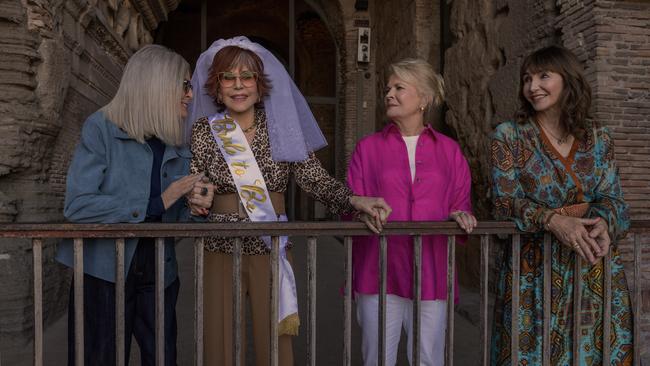John Farnham movie a story of beating the odds
For long stretches John Farnham and his dancer wife, who have two sons, were ‘on the bones of our arse’, as she puts it. Then everything changed.

John Farnham: Finding the Voice (M)
In cinemas from May 18
★★★½
As someone who did not know a lot about Australia’s five-time King of Pop, I learned a lot from John Farnham: Finding the Voice.
First, how handsome he was as a young man. The late-teen/early 20s Johnny Farnham we see in this 92-minute documentary was a good sort, as my mother would say. His wife of 50 years, Jillian Billman, remembers that when they met on the set of the 1973 stage musical Charlie Girl, he was easy going and approachable. And, she adds, “Very cute. Mmmmm. Very cute.” Liberace had similar feelings when he presented Johnny with his third King of Pop award in 1971. He looked the young man up and down, admired his outfit and said, “I have one to match.”
Second, the mullet haircut, which Farnham favoured in the 80s and 90s, is a no-go. Not even George Clooney could pull one off in the TV series The Facts of Life.
Third, that Sadie (The Cleaning Lady), the soapy song that 17-year-old Farnham took to No.1 on the Australian singles charts in 1967, became an albatross around his neck.
Throughout this film, directed and co-written by Poppy Stockell, there’s a frequent answer to the question of whether someone would like to sign up Johnny then John Farnham. It goes something like this: “You mean the bloke who sang Sadie? No way.”
This nods to the title: Finding the Voice. I did not know that he struggled for so long to be recognised for his talents. Or that for long stretches he and his dancer wife, who have two sons, were “on the bones of our arse’’, as she puts it.
It wasn’t that people doubted he could sing. “He’s my favourite singer,” says his friend the late Olivia Newton-John. “It’s a vocal masterclass,” the American singer-songwriter Richard Marx says of Farnham’s 1980 single Help.
It was Sadie, and mediocre management at the outset of his career, that held him back. Even when he replaced Glenn Shorrock at The Little River Band, between 1980 and 1985, he was still stranded somewhere between pop and rock.
“You can put a pair of leather pants on that man,’’ says Gaynor Wheatley, “but it does not make him Jimmy Barnes.” She says this as a friend, and with some inside knowledge. Her husband, Glenn Wheatley, a rock musician himself, became Farnham’s manager and best mate.
The breakthrough came soon after, with the 1986 song the title alludes to, You’re the Voice, and the associated album Whispering Jack.
The aforementioned Jimmy Barnes remembers what he thought on first hearing the song: “This is dangerous. He’s going to be really big.”
The background to the creation of Whispering Jack and its No.1 single is fascinating. Farnham listened to about 2000 songs, mostly sent in as demo tapes, to choose the tracks.
One he rejected as “too twee” was We Built This City, which ended up with the American band Starship and went to No.1 in the US.
And You’re the Voice, which topped the charts in Australia and overseas, has its own interesting backstory. It took a while to make it work, particularly the use of bagpipes. One of the highlights of this film is seeing Farnham, in leather pants, belt it out before a huge crowd in West Berlin, with the dividing wall still standing.
This documentary is the feature debut of Stockell, a former radio producer and programmer, including on the ABC’s Triple J. It must have been a challenging film to make. Last year, Newton-John and Glenn Wheatley both died, and Farnham underwent surgery for mouth cancer.
Wheatley is interviewed and his wife Gaynor is a significant contributor, as is Farnham’s wife Jillian. Their sons also offer their thoughts. Old bandmates like Tommy Emmanuel and rivals such as Jimmy Barnes add background notes. Farnham, 73, does make some comments but not on camera and not at great length. “I was in every beat of every bar,’’ he says of You’re the Voice.
This is an inspiring story of someone who had to overcome the odds, including that dreaded mop and bucket, to be who he wanted and deserved to be.
Book Club: The Next Chapter (M)
In cinemas
★★
What do you get when you put three Academy Award winners in a movie that has almost no plot and just a skerrick of a script?
Anything is possible in Hollywood but in the case of Book Club: The Next Chapter, you get a frustratingly bad film.
Let’s start by accentuating the positive.
It’s wonderful to see the aforementioned Oscar winners Diane Keaton, Jane Fonda and Mary Steenburgen, along with Candice Bergen, starring in a film about women their own ages – 70s and 80s – who live life to the full.
It’s fun that they play around with their real life approach to ageing. Fonda, who is 85, adds a touch of whimsy. Youthful appearance, her character says, “does not just happen on its own”.
The frustration is that four first-rate actors are in a movie that goes almost nowhere and when it briefly does go somewhere it detours into poor taste and patriarchal inclinations. On the latter, the men in this movie – Andy Garcia, Don Johnston and Craig T. Nelson – have bit roles.
It would be praise to say they phone them in. They text them in.
Yet, ultimately, it is they, the men in the women’s lives, who matter most.
This movie is a sequel to Book Club (2018) and all the leads return, as does director Bill Holderman, who also wrote the script. That first instalment happens in the US and is about four women who have been friends forever and have a book club. On reading EL James’s Fifty Shades of Grey, they decide it’s time to go for a little leather.

In this next – and one hopes final – chapter, Vivian (Fonda), Diane (Keaton), Carol (Steenburgen) and Sharon (Bergen), agree, post-Covid lockdowns, to head to Italy. The literary influence is Paul Coelho’s 1998 novel The Alchemist, which may explain the cliches that follow. The spark is Viv’s announcement that she and her beau Arthur (Johnson) are engaged.
Viv, who has never married, explains her change of mind in a perceptive line: “In another 50 years I might not find him as attractive as I do now.”
So it’s off to Rome as the starting point of Viv’s bachelorette party. Here, too, there are funny moments where the women look at ancient figures and wonder if they are contemporaries.
They also joke about the rock-hard penises of the male statues, and this is OK, as is most of the sexual innuendo that rises throughout the film.
But when you have a 107-minute movie with no plot, you have to fill in the gaps, and this is where the poor taste comes in. The joke about Mother Teresa, whether you think she is saint or sinner, is high school and tawdry.
Garcia is Diane’s beau, Nelson is Carol’s husband. Sharon, a retired judge, is the one without a man in her life, though she does hate/like an Italian police chief they meet.
The final 20 minutes or so brings the men front and centre and, for this viewer, it’s saccharine enough to induce mild nausea. It’s the pin that punctures the balloon that this is a film about female friendship.
I’m going two stars because I like seeing Fonda, Keaton, Steenburgen and Bergen on the screen. Without them it’s a one star film at best. They deserve better.


To join the conversation, please log in. Don't have an account? Register
Join the conversation, you are commenting as Logout